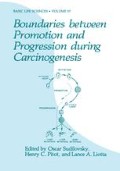Abstract
Moderator (Lance A. Liotta): We can summarize our presentations today as follows: We have seen evidence that multiple genes are amplified, increased in expression, or lost, and this correlates with tumorigenesis and progression to metastases. Others may be are up-regulated genes that encode for enzymes or cytoskeletal elements. Some of these may be so-called suppressor genes. Their function is unknown. There may be even suppressor genes for the metastatic phenotype, and I’ll present evidence for a putative metastases suppressor gene we’ve cloned tomorrow. But all of these relationships are correlative in nature, that is, we’re correlating the changes of genetic expression with the biologic phenotype, and so the unanswered question is of course the causal relationship between any of them and progression of the tumor. In the future we need to develop means of specifically inhibiting the genes of interest, so we can really study their causal nature. If we could inhibit a ras gene product or inhibit any of the other putative genes that play a role in progression with some antisense mechanism, then maybe we could really see if they are necessary or just correlated. I believe that there will be a revolution in pathology, in terms of using combinations of genes and their relative amplification or expression or loss as a new way of predicting the prognosis for an individual patient’s tumor. I foresee a situation in which the pathologist will not just look under the microscope at the tumor but will analyze the relative pattern of gene imbalance in the tumor DNA or in their pattern of expression. I think that no matter what the role of these genes is, ultimately we will find out that their importance for prognosis is unquestionable. I think another point that should be raised in this regard is which genes are more important to study and which have the better prognostic indication than others. We’ve seen that a source of major controversy is the role of the erbB-2 gene, as shown by Slamon, et al. originally. This correlates with breast cancer aggressiveness, and I believe many pathology labs are poised to measure this gene in their tumor samples. The difference of opinions demonstrate a major gap in our resources. We do not have existing a very large tumor bank that scientists throughout the country can use. What we need is a bank of hundreds and hundreds of tumors with known clinical backgrounds, which differ in low aggressiveness, high aggressiveness, high propensity for metastases, and different states of histologic classification. I would hope that we will be able to gather the resources of pathologists and physicians around the country to create such a bank. We’re not talking necessarily about viable tumors, but just DNA, so that we can extend these correlative studies to much larger studies. Maybe some of the members of the audience who’ve been working in the field of tumor banking can add something to this question. I’d like now to pose these questions to our discussion leaders and to invite anyone else who wants to join in.
Access this chapter
Tax calculation will be finalised at checkout
Purchases are for personal use only
Preview
Unable to display preview. Download preview PDF.
References
Beckmann, A., et al, “Detection and localization of Human Papilloma Virus DNA in human genital condylomata by in situ hybridization with biotinylated probes. J. Med. Virol. 16:265–273, 1985.
Review: Grody, W.W., et al., “In situ viral DNA hybridization in diagnostic surgical pathology.” Human Path. 18:535–543, 1987.
Author information
Authors and Affiliations
Editor information
Editors and Affiliations
Rights and permissions
Copyright information
© 1991 Plenum Press, New York
About this chapter
Cite this chapter
Sudilovsky, O., Pitot, H.C., Liotta, L.A. (1991). Summary Discussion. In: Sudilovsky, O., Pitot, H.C., Liotta, L.A. (eds) Boundaries between Promotion and Progression during Carcinogenesis. Basic Life Sciences, vol 57. Springer, Boston, MA. https://doi.org/10.1007/978-1-4684-5994-4_18
Download citation
DOI: https://doi.org/10.1007/978-1-4684-5994-4_18
Publisher Name: Springer, Boston, MA
Print ISBN: 978-1-4684-5996-8
Online ISBN: 978-1-4684-5994-4
eBook Packages: Springer Book Archive

